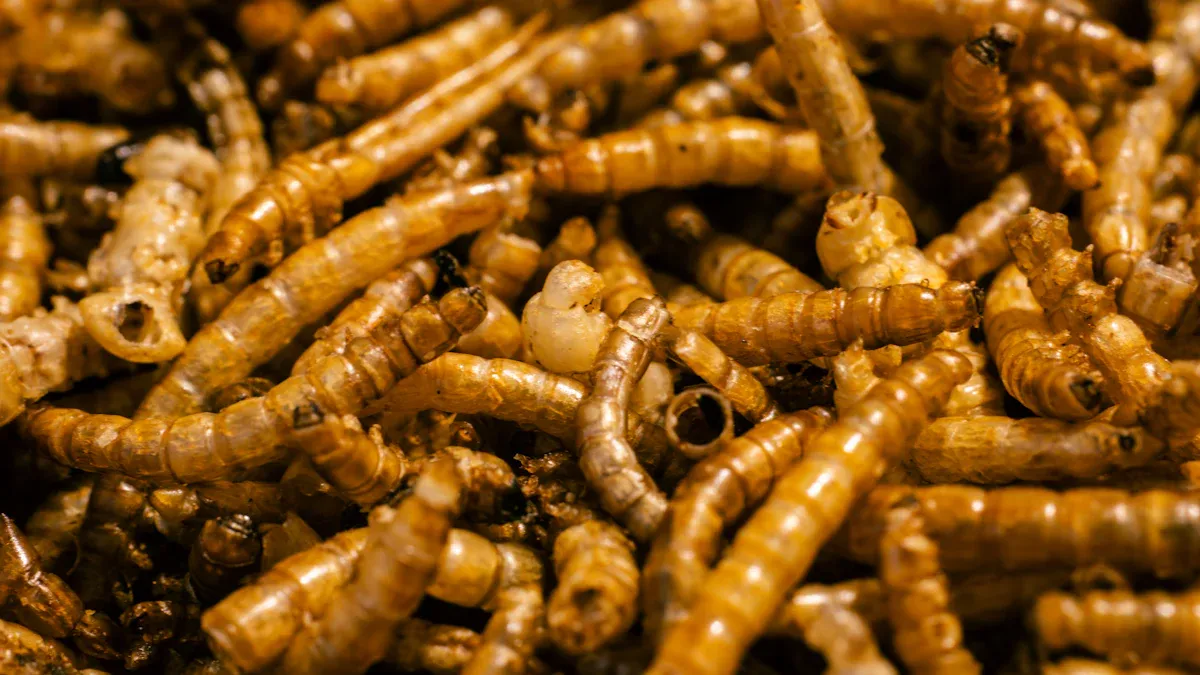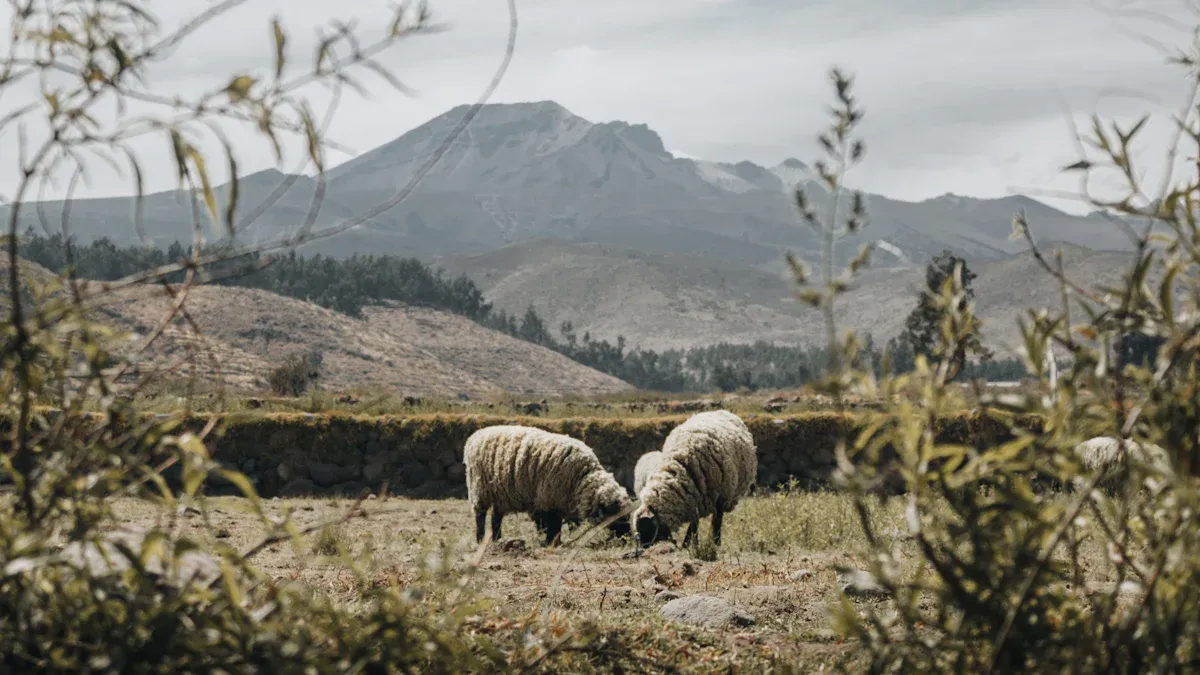
Have you ever wondered how to make animal feed more sustainable and nutritious? Mealworms might just be the answer. These tiny insects are packed with 48% protein by weight, offering energy levels that surpass soy. Plus, they require less land, water, and feed to produce.
- The global market for mealworms is booming as farmers look for eco-friendly protein sources.
- Developing countries are especially embracing them to tackle protein shortages.
Mealworms for animal feed are a game-changer. They’re efficient, sustainable, and loaded with nutrients your animals need.
Key Takeaways
- Mealworms are a great protein source with 48% protein. They are perfect for animals like chickens, fish, and small pets.
- Feeding animals mealworms helps the environment. They need less land, water, and energy than regular livestock. Mealworms also recycle food waste.
- Adding mealworms to animal diets makes animals healthier. It strengthens their immune systems and helps them perform better.
High-Quality Protein Source
Essential for growth and development
Protein is the building block of life, and mealworms are packed with it. They contain about 48% protein by weight, which is comparable to soy’s 50%. However, mealworms go a step further by offering more total energy per pound and lower ash and crude fiber content. This makes them an excellent choice for animals that need high-quality protein to grow strong and healthy.
Different animals benefit from mealworms in unique ways. For reptiles, the protein helps build energy reserves and supports robust growth. Fish thrive on mealworms too, as the nutrients enhance their vibrant colors and overall development. Small mammals, like hamsters or rabbits, rely on this protein to maintain muscle and stay active. Even chickens benefit—mealworms promote feather growth and improve egg production.
Mealworms for Animal Feed provide the kind of protein animals need to thrive, making them a smart addition to any diet.
Prevents nutrient deficiencies
Mealworms don’t just deliver protein—they also come with essential fats, B vitamins, and minerals like iron and calcium. These nutrients play a vital role in preventing deficiencies that could harm your animals. For example, B vitamins boost energy metabolism, while calcium strengthens bones and supports the immune system.
By feeding your animals mealworms, you’re giving them a balanced diet that keeps them healthy and active. Whether you’re raising chickens, fish, or small mammals, mealworms ensure they get the nutrients they need to avoid common health issues.
Nutrient-Rich Feed Option
Packed with vitamins and minerals
Mealworms are more than just a protein source—they’re a powerhouse of essential vitamins and minerals. When you add them to your animal feed, you’re providing a nutrient boost that supports energy, growth, and overall health.
Here’s what makes mealworms stand out:
- They’re rich in B vitamins like B12 and B2, which help animals convert food into energy.
- Essential minerals such as iron, calcium, magnesium, and zinc promote strong bones and a healthy immune system.
- They also contain phosphorus and potassium, which are vital for muscle function and maintaining fluid balance.
The best part? The nutritional profile of mealworms can vary based on their diet. For example, mealworms fed potato cuttings have higher fat content and unique fatty acids. This means you can tailor their diet to meet specific nutritional needs for your animals.
By choosing mealworms, you’re giving your animals a natural and nutrient-packed feed option.
Supports overall animal health
Adding mealworms to your feed isn’t just about nutrition—it’s about improving your animals’ well-being. Studies show that mealworms are an excellent protein-rich supplement for livestock. They help animals grow stronger, stay active, and resist common health issues.
Mealworms also contribute to sustainability. By using them, you’re reducing the environmental impact of traditional feed sources. Plus, they can be farmed using organic byproducts, making them an eco-friendly choice.
When your animals eat mealworms, they get the nutrients they need to thrive. Whether it’s chickens, fish, or small mammals, mealworms support their health from the inside out.
Mealworms for Animal Feed are a smart way to keep your animals healthy while promoting sustainable farming practices.
Environmentally Friendly Choice

Low resource requirements
Mealworms are a fantastic choice if you’re looking to reduce the resources needed for animal feed. Unlike traditional livestock, they require much less land, water, and energy to produce. Here’s why mealworms stand out:
- They need only a fraction of the water used for raising cattle, making them ideal for areas with limited water supplies.
- Mealworms can be farmed vertically in indoor facilities, saving valuable land space.
- Their feed conversion efficiency is similar to poultry, but they use nitrogen more effectively, which means less waste.
Another great thing about mealworms is their ability to thrive on organic waste. They can process about 4 kilograms of organic material to produce 1 kilogram of mealworms. This not only reduces landfill waste but also turns it into valuable protein for your animals. Plus, the waste they produce, called frass, is a nutrient-rich fertilizer that improves soil health.
By choosing mealworms, you’re not just feeding your animals—you’re conserving resources and helping the planet.
Reduces environmental impact
Mealworms are a game-changer when it comes to reducing the environmental footprint of animal feed. Compared to traditional livestock, they produce far fewer greenhouse gases like methane and ammonia. For example, mealworms generate significantly less CO2, N2O, and CH4 than cattle, pigs, or chickens.
Here’s a quick comparison of their environmental benefits:
| Environmental Benefit | Description |
|---|---|
| Reduced land use | Mealworms need only 10% of the land required for beef production. |
| Lower greenhouse gas output | They emit far less methane and other harmful gases than livestock. |
| Waste management potential | Mealworms convert organic waste into protein, reducing landfill waste. |
| Frass as fertilizer | Their waste product enriches soil and reduces the need for synthetic inputs. |
By incorporating mealworms into your feed strategy, you’re not only supporting your animals but also contributing to a healthier planet. Mealworms for Animal Feed offer a sustainable solution that aligns with eco-friendly farming practices.
Cost-Effective Solution
Saves on feed expenses
Feeding your animals doesn’t have to break the bank. Mealworms offer a cost-effective alternative to traditional feed ingredients like soy or fishmeal. They require less processing, which means lower production costs. Plus, you can integrate them into existing feed systems without expensive upgrades.
Mealworms also consume a wide range of organic byproducts, such as grain leftovers, dried weeds, and even animal manure. This flexibility reduces feed input costs while turning waste into valuable protein. It’s a win-win for your wallet and the environment.
Here’s how mealworms compare to cows in terms of efficiency:
| Metric | Mealworms | Cows |
|---|---|---|
| Food Conversion Ratio | 2:1 | 8:1 |
| Water Use Efficiency | 500 times better | N/A |
| Space Productivity | 17 times more | N/A |
By switching to mealworms, you can save on feed expenses while maximizing your resources.
💡 Tip: Mealworms for Animal Feed are not only affordable but also sustainable, making them a smart choice for modern farming.
High feed conversion efficiency
Mealworms are champions of feed efficiency. They convert feed into protein as effectively as poultry, requiring just 2 pounds of food to produce 1 pound of body weight. Compare that to cows, which need 8 pounds of food for the same result.
Their nitrogen use efficiency is also higher than traditional livestock. This means less waste and more nutrients going directly into your animals. With mealworms, you get more protein for every pound of feed, which translates to better value for your money.
Switching to mealworms doesn’t just save you money—it boosts your farm’s productivity. Whether you’re raising chickens, fish, or small mammals, mealworms deliver high-quality nutrition without the high costs.
Enhances Digestive Health
Promotes gut microbiome balance
Did you know that mealworms can help keep your animals’ digestive systems in top shape? These tiny insects do more than just provide nutrients—they actively support a healthy gut microbiome. A balanced gut microbiota is essential for your animals. It helps them absorb nutrients better, fight off infections, and maintain overall health.
Mealworms, especially yellow mealworms (Tenebrio molitor), contain chitin in their exoskeletons. Chitin is a natural polysaccharide that works wonders for gut health. It boosts the immune system and helps regulate the composition of gut bacteria. Studies show that including mealworms in poultry diets positively impacts their gastrointestinal tract by promoting beneficial bacteria. This means fewer digestive issues and healthier animals.
Adding mealworms to your feed is like giving your animals a gut health boost.
Improves nutrient absorption
Mealworms don’t just stop at improving gut health—they also enhance how well your animals absorb nutrients. Their high protein content (48% by weight) and low crude fiber make them easier to digest compared to traditional feed options like soy. This means your animals get more energy and nutrients from every bite.
Research backs this up. For example, African catfish fed mealworm-based diets showed increased fat content, while rainbow trout experienced higher protein levels. Even European sea bass maintained optimal body composition when mealworms made up less than 50% of their diet. The secret lies in mealworms’ nutrient density and digestibility, which help animals make the most of their feed.
Mealworms for Animal Feed aren’t just nutritious—they’re efficient, helping your animals thrive with every meal.
Strengthens Immune System
Contains bioactive compounds
Mealworms are more than just a nutritious snack for your animals—they’re packed with bioactive compounds that can supercharge their immune systems. One of these compounds is chitin, found in the exoskeleton of mealworms. Chitin plays a key role in stimulating the innate immune response, which is the first line of defense against infections. Since animals like livestock can’t produce chitin on their own, adding mealworms to their diet gives them a much-needed boost.
But that’s not all. Mealworms (Tenebrio molitor) also produce antimicrobial peptides (AMPs). These tiny proteins fight off harmful bacteria and other pathogens. Think of AMPs as nature’s antibiotics, helping your animals stay healthy without relying on synthetic drugs. By including mealworms in your feed, you’re giving your animals a natural way to strengthen their immune systems and stay resilient.
🛡️ Fun Fact: Chitin and AMPs in mealworms don’t just protect animals—they also reduce the need for antibiotics, promoting healthier and more sustainable farming practices.
Boosts disease resistance
Feeding your animals mealworms doesn’t just improve their immunity—it also helps them resist diseases. Research shows that mealworms raised under specific conditions, like higher densities, develop stronger defenses against pathogens. For example, they show enhanced melanization, a natural process that protects against infections.
When animals consume mealworms, they benefit from these immune-boosting properties. Studies have shown that animals fed mealworm-based diets experience fewer illnesses and recover faster when exposed to diseases. This makes mealworms a powerful addition to your feed strategy.
By choosing mealworms for animal feed, you’re not only improving your animals’ health but also reducing the risk of disease outbreaks. It’s a win-win for you and your farm.
Versatile Feed Ingredient
Suitable for various animals
Mealworms are incredibly versatile and can benefit a wide range of animals. Whether you’re raising chickens, reptiles, fish, or small mammals, mealworms provide the nutrients they need to thrive.
Here’s how different animals benefit:
- Reptiles: Mealworms deliver high protein and energy, supporting growth and vitality.
- Fish: They enhance vibrant colors and promote healthy development.
- Small Mammals: Animals like hamsters and hedgehogs gain muscle maintenance and overall health.
- Chickens: Mealworms improve feather growth and boost egg production.
Mealworms also work well for fish farms. They can replace fishmeal, which is often derived from wild fish populations. This not only supports the growth of farmed fish but also helps conserve marine ecosystems.
🐓 Fun Fact: Chickens love mealworms as a treat, making feeding time more enjoyable for both you and your flock!
Easy to integrate into diets
Adding mealworms to your animals’ diets is simpler than you might think. They can replace up to 25% of traditional protein sources like soybean meal. With 48% protein by weight, mealworms offer a comparable alternative to soy while providing more energy and easier digestibility.
Here’s how you can integrate mealworms into your feed:
- Preparation: Partner with mealworm producers or start your own production for a steady supply.
- Processing: Dry and grind mealworms to mix them seamlessly into feed.
- Feed formulation: Consult a nutritionist to ensure the feed meets all dietary needs.
- Mixing and Delivery: Blend mealworm meal thoroughly into the feed and adjust feeding practices as needed.
Mealworms for Animal Feed are not only nutritious but also adaptable. Whether you’re feeding poultry, fish, or small mammals, they fit right into existing feeding systems without hassle.
💡 Tip: Start small by replacing a portion of traditional protein sources with mealworms and observe the positive changes in your animals’ health and performance.
Reduces Food Waste
Utilizes organic byproducts
Mealworms are nature’s recyclers. They thrive on organic byproducts that would otherwise go to waste. You can feed them materials like wheat bran, oats, dried grasses, straw, and even grain dust. They also process agricultural waste and herbivore manure. These are items that often end up as waste streams, but mealworms turn them into something valuable.
By using these byproducts, you’re not just feeding mealworms—you’re reducing food waste. Think about it: instead of throwing away wheat bran or vegetable scraps, you can use them to grow mealworms. This practice is both cost-effective and eco-friendly. It’s a simple way to make the most of resources that are already available.
♻️ Fun Fact: Mealworms can even consume agricultural leftovers, helping farmers cut down on waste while producing high-quality protein for animals.
Converts waste into valuable protein
Mealworms don’t just eat waste—they transform it. For every kilogram of mealworms you harvest, they process about 4 kilograms of organic waste. That’s a lot of waste being turned into protein-rich feed! Their gut microbes help break down food scraps, vegetable peels, and other organic materials. This process reduces the amount of waste going to landfills and lowers greenhouse gas emissions.
By incorporating mealworms into your feed strategy, you’re creating a sustainable cycle. Organic waste becomes a resource instead of a problem. Plus, the protein they produce is a great alternative to traditional options like soy. It’s a win for your animals and the environment.
Mealworms for Animal Feed offer a unique solution to food waste. They help you manage waste while providing a high-quality, sustainable protein source.
Aligns with Ethical Farming
Meets consumer demand for sustainability
Consumers today care more about where their food comes from and how it’s produced. They want farming practices that protect the planet and promote sustainability. Mealworms for Animal Feed align perfectly with these values.
Here’s why sustainability matters to consumers:
- A Nielsen study found that sustainably labeled products grew by 20% between 2014 and 2018, compared to just 3% for conventional products.
- Over 450,000 acres of farmland in North America are transitioning to regenerative practices, showing a clear demand for eco-friendly farming.
- According to The Hartman Group, 85% of consumers believe agriculture should positively impact the environment.
By incorporating mealworms into your feed strategy, you’re not just meeting these expectations—you’re exceeding them. Mealworms offer a sustainable protein source that reduces waste and lowers the environmental footprint of farming. This makes your farm more appealing to eco-conscious buyers.
🌱 Pro Tip: Highlight your use of mealworms in your marketing to attract sustainability-focused consumers.
Encourages responsible practices
Mealworms encourage responsible farming by turning waste into valuable resources. They consume organic materials like kitchen scraps, agricultural residues, and even lawn clippings. For every kilogram of mealworms harvested, they process about 4 kilograms of organic waste. This reduces landfill contributions and helps manage pollution from animal manure.
Using mealworms also promotes responsible protein sourcing. They provide an alternative to soy, which often contributes to deforestation. By choosing mealworms, you’re supporting a more ethical and sustainable farming system.
Farmers worldwide are adopting mealworms to improve their practices. They’re cutting costs, reducing waste, and creating a healthier environment for their animals. You can do the same by integrating mealworms into your feed strategy. It’s a small change with a big impact.
♻️ Fun Fact: Mealworms don’t just help your farm—they help the planet by reducing waste and conserving resources.
Improves Feed Palatability
Increases feed intake
Animals love mealworms. Their natural flavor and high-quality protein make them far more appealing than traditional feed options. Poultry, for example, eagerly peck at mealworms, treating them as a favorite snack. Reptiles like geckos and lizards also thrive on mealworms as a primary food source. Even dogs, cats, pigs, and fish show a clear preference for mealworms over regular commercial feed.
When animals enjoy their food, they eat more of it. This increased feed intake ensures they get the nutrients they need to grow stronger and stay healthy. By adding mealworms to your feed, you’re not just providing nutrition—you’re giving your animals something they’ll genuinely enjoy.
🐓 Fun Fact: Chickens often go wild for mealworms, making feeding time both fun and productive!
Enhances animal performance
When animals eat more, they perform better. Mealworms, with their 48% protein content, deliver the energy and nutrients animals need to thrive. Compared to soy, mealworms provide more total energy per pound and contain less ash and crude fiber. This makes them easier to digest and more efficient as a feed option.
The combination of high palatability and superior nutrition leads to noticeable improvements in animal performance. Chickens fed mealworms produce better-quality eggs and grow healthier feathers. Fish raised on mealworm-based diets show vibrant colors and robust growth. Even small mammals and reptiles benefit from improved muscle maintenance and activity levels.
By choosing mealworms for animal feed, you’re not just feeding your animals—you’re helping them reach their full potential.
Mealworms for Animal Feed offer a sustainable, nutrient-rich, and cost-effective solution for modern farming. They require minimal resources, produce fewer greenhouse gases, and even recycle organic waste into valuable protein.
By choosing mealworms, you can improve animal health, reduce your farm’s environmental footprint, and align with ethical farming practices. Why not make the switch today for a healthier, more sustainable future?
FAQ
1. Can mealworms completely replace traditional feed?
Mealworms can replace up to 25% of traditional protein sources like soy. They’re a great supplement but not a full replacement for balanced diets.
2. Are mealworms safe for all animals?
Yes, mealworms are safe for most animals, including chickens, fish, reptiles, and small mammals. Always consult a nutritionist for specific dietary needs.
3. How do I store mealworms for feed?
Store dried mealworms in a cool, dry place. For live mealworms, keep them in a ventilated container with bran or oats as bedding.
🐛 Pro Tip: Freeze live mealworms to extend their shelf life and prevent them from pupating.


